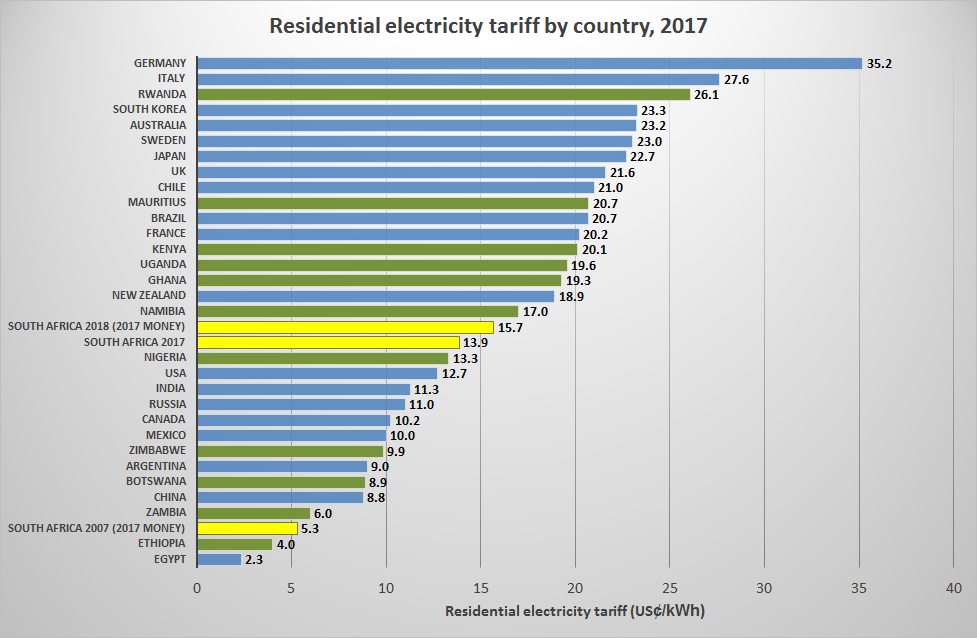4.2.1 Case intro Eskom
Course subject(s)
Module 4. Affordability
Welcome to this module’s case!
This case is on Eskom, the main electricity provider in South Africa.
This case consists of three elements:
- The introduction in this section.
- Reading material
- The case quiz on both the introduction and the readings.
We hope you enjoy this case!
In South Africa, more than 40% of the population is considered energy poor. The poorest people spend 27% of their income on energy, which is far above the usual 10% threshold. This energy poverty is surprising, as 70% of South Africa’s energy mix is coal, which is the cheapest energy source (compared to oil and gas). Furthermore, this coal does not have to be imported – South Africa has so much coal that 92% of the coal consumed in Africa is mined in South Africa9. However, electricity prices have almost tripled from 2007 to 2017 (see figure) and are now average among Sub-Saharan countries.

Electricity prices of South Africa (yellow, different years), other Sub-Saharan countries (green) and other countries (blue). Source.
However, high electricity prices are not the only problem; South Africa has a history in rotating blackouts and these are occurring more and more often again. Rotating blackouts are planned blackouts of different parts of the electricity grid when not enough electricity supply can be generated to meet demand. These rotating blackouts are a form of load shedding, and the problems at Eskom, the electricity provider of South Africa are only increasing. Eskom recently extended the load shedding process from 4 to 8 stages, which allows for up to 8000 MW (about ⅕ of peak power demand) of power to be shed in extreme circumstances instead of 4000 MW.
Since the end of apartheid in 1994, South Africa has expanded its grid to previously neglected black areas. This, and the expanding economy, have resulted in a sharp increase in electricity demand that was not foreseen by Eskom. Capacity additions were announced in the mid-2000s, when the problem was recognised. The Medupi and Kusile coal plants were scheduled to be built. However, these coal plants, two of the biggest in the world, are still years away from completion, while they were supposed to be completely operational in 2015. In addition, a lack of money resulted in bad maintenance on power plants that are in operation. To make it worse, these power plants are nearing or already at the preferred retirement age.
But now the wealthiest people are bailing out of using the normal grid by installing own generators and, in increasing numbers, solar panels and batteries to ensure electricity supply to their businesses and homes. This causes further problems to Eskom, because those who do not have this option, often have trouble paying the energy bills. Eskom drastically needs revenue to continue their business and the debt is a huge $30 billion and still increasing. The need for Eskom to higher its prices causes even more energy poverty.
To solve this problem, president Ramaphosa wants to split the company, that provides 95% of the electricity in South-Africa, in three parts that will deal with generation, transmission and distribution. This should make it easier to raise funds and cut costs for every individual company. Eskom itself proposed that the government would take some of its debts and is considering selling assets and firing employees.
- How close is Eskom to a total blackout?
- A solar light at the end of the Eskom tunnel?
- South Africa Yields Rise, Eskom’s Fall as Bailout Talk Grows
- Energy bidding strategies for restructured electricity market
- Eskom crisis: Why the lights keep going out in South Africa
- Load shedding
- Tackling urban energy poverty in South Africa
- Why Eskoms power crisis is South Africa’s top risk
- Introduction to Eskom

Inclusive Energy Systems: Exploring Sustainable Energy for All by TU Delft OpenCourseWare is licensed under a Creative Commons Attribution-NonCommercial-ShareAlike 4.0 International License.
Based on a work at https://online-learning.tudelft.nl/courses/inclusive-energy-systems-exploring-sustainable-energy-for-all///.



